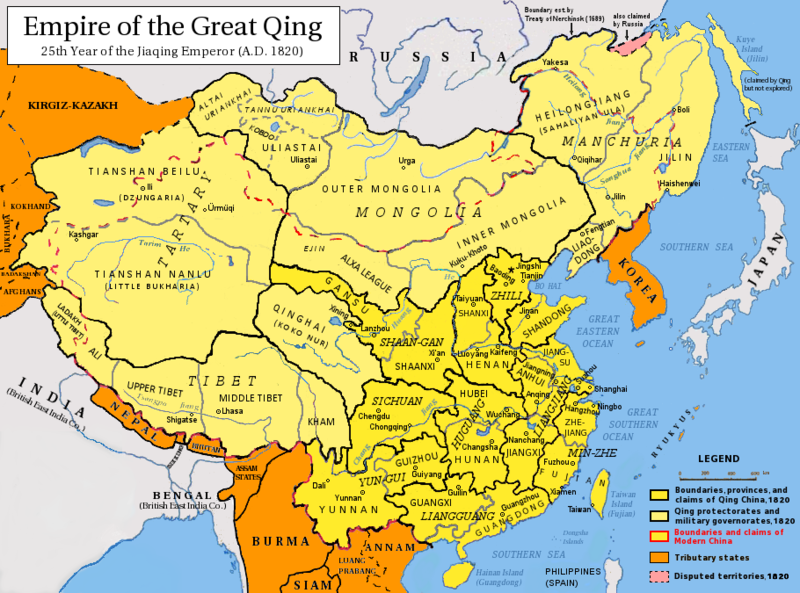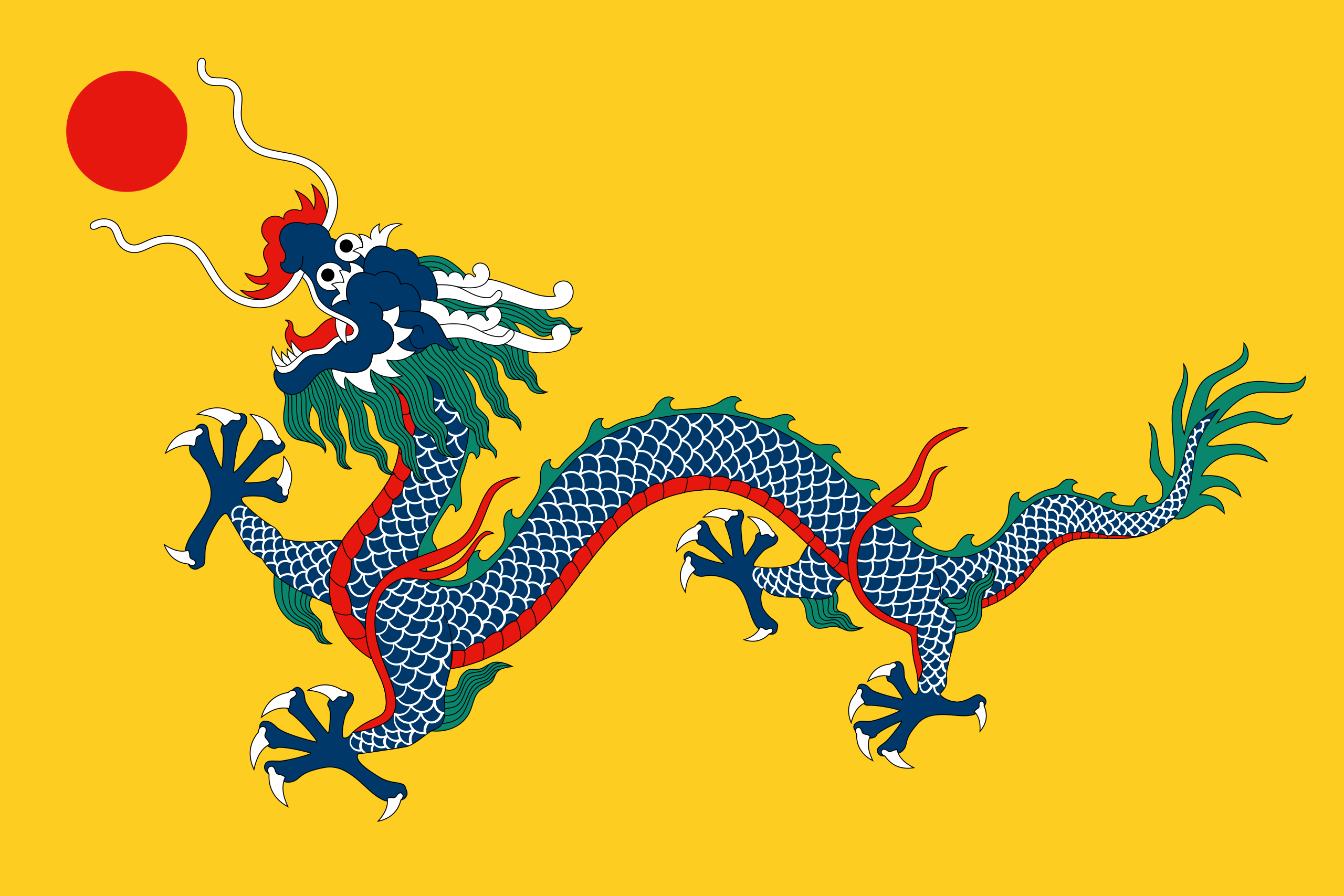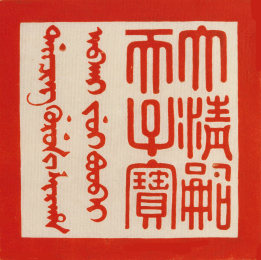More languages
More actions
mNo edit summary Tag: Visual edit |
(Taiping and Boxer rebellions) Tag: Visual edit |
||
| Line 1: | Line 1: | ||
{{Distinguish|[[Qin dynasty]]}}{{Infobox country|name=Great Qing|native_name=大清<br>ᡩᠠᡳ᠌ᠴᡳᠩ ᡤᡠᡵᡠᠨ<br>གྲེཨཏ་ཆིང|year_start=1636|year_end=1912|image_symbol=Qing imperial seal.png|capital=Beijing|largest_city=Beijing|government_type=Absolute monarchy (1636-1911)<br>Constitutional monarchy (1911-1912)|mode_of_production=Feudalism|area_km2=14,700,000|image_map_caption=The Qing Dynasty in 1820 C.E.|common_languages=Mandarin, Mongolian, Manchu, Tibetan|population_estimate=432,000,000|population_estimate_year=1912|image_flag=Qing flag.png|flag_caption=Flag (1889–1912)|image_map=Map of Qing Dynasty 1820.png}} | {{Distinguish|[[Qin dynasty]]}}{{Infobox country|name=Great Qing|native_name=大清<br>ᡩᠠᡳ᠌ᠴᡳᠩ ᡤᡠᡵᡠᠨ<br>གྲེཨཏ་ཆིང|year_start=1636|year_end=1912|image_symbol=Qing imperial seal.png|capital=Beijing|largest_city=Beijing|government_type=Absolute monarchy (1636-1911)<br>Constitutional monarchy (1911-1912)|mode_of_production=[[Feudalism]]|area_km2=14,700,000|image_map_caption=The Qing Dynasty in 1820 C.E.|common_languages=Mandarin, Mongolian, Manchu, Tibetan|population_estimate=432,000,000|population_estimate_year=1912|image_flag=Qing flag.png|flag_caption=Flag (1889–1912)|image_map=Map of Qing Dynasty 1820.png}} | ||
The '''Qing dynasty''' was the last dynasty to control [[People's Republic of China|China]]. It was established in 1636 by [[Hong Taiji]], an ethnic [[Manchu people|Manchu]],<ref>{{Citation|author=Evelyn S. Rawski|year=1991|title=Marriage and Inequality in Chinese Society|chapter=Ch'ing Imperial Marriage and Problems of Rulership|section=|page=177|quote=|pdf=|city=|publisher=University of California Press|isbn=9780520069305|doi=|lg=|mia=|title-url=|chapter-url=|trans-title=|trans-lang=}}</ref> as a successor to the [[Later Jin (1616–1636)|Later Jin dynasty]]. While initially isolated to [[Manchuria]] (Northeastern China), the fall of the [[Ming dynasty (1368–1644)|Ming dynasty]] in 1644 allowed the Qing to spread all throughout China and beyond. It stayed in power until the [[Xinhai Revolution]] of 1912, a [[bourgeois revolution]] which would lead to the creation of the [[Republic of China]]. | The '''Qing dynasty''' was the last dynasty to control [[People's Republic of China|China]]. It was established in 1636 by [[Hong Taiji]], an ethnic [[Manchu people|Manchu]],<ref>{{Citation|author=Evelyn S. Rawski|year=1991|title=Marriage and Inequality in Chinese Society|chapter=Ch'ing Imperial Marriage and Problems of Rulership|section=|page=177|quote=|pdf=|city=|publisher=University of California Press|isbn=9780520069305|doi=|lg=|mia=|title-url=|chapter-url=|trans-title=|trans-lang=}}</ref> as a successor to the [[Later Jin (1616–1636)|Later Jin dynasty]]. While initially isolated to [[Manchuria]] (Northeastern China), the fall of the [[Ming dynasty (1368–1644)|Ming dynasty]] in 1644 allowed the Qing to spread all throughout China and beyond. It stayed in power until the [[Xinhai Revolution]] of 1912, a [[bourgeois revolution]] which would lead to the creation of the [[Republic of China]]. | ||
The dynasty suffered from the [[imperialism]] of [[Japan]] and [[Europe]] and lost [[Hong Kong Special Administrative Region|Hong Kong]] to [[United Kingdom of Great Britain and Northern Ireland|Britain]] after the [[First Opium War]] in 1839.<ref>{{Citation|author=|year=1847|title=China; political, commercial, and social; an official report|chapter=|section=|page=84|quote=|pdf=|city=London|publisher=James Madden|isbn=|doi=|lg=|mia=|title-url=https://archive.org/details/chinapoliticalc00martgoog/page/84/mode/2up|chapter-url=|trans-title=|trans-lang=}}</ref> In 1895, the Qing dynasty lost control over [[Taiwan Province|Taiwan]] and [[Joseon dynasty|Korea]] in the [[First Sino-Japanese War]] when they were taken over by Japan.<ref>{{Citation|author=Jinwung Kim|year=2012|title=A History of Korea: From "Land of the Morning Calm" to States in Conflict|chapter=|section=|page=304|quote=|pdf=|city=New York City|publisher=Indiana University Press|isbn=9780253000248|doi=|lg=|mia=|title-url=|chapter-url=|trans-title=|trans-lang=}}</ref> The [[Boxer Rebellion]] at the turn of the century attempted to reestablish China's sovereignty but was crushed by [[Eight-Nation Alliance|a Western military alliance]] which included the [[United States of America|United States]], [[Austro-Hungarian Monarchy (1867–1918)|Austria-Hungary]], Britain, [[French Third Republic (1870–1940)|France]], and others.<ref>{{Web citation|author=Razmy Baroud|newspaper=[[MintPress News]]|title=Xi vs Trudeau: How China Is Rewriting History with the Colonial West|date=2022-11-28|url=https://www.mintpressnews.com/xi-trudeau-china-rewriting-competition-with-west/282824/|archive-url=https://web.archive.org/web/20221128173353/https://www.mintpressnews.com/xi-trudeau-china-rewriting-competition-with-west/282824/|archive-date=2022-11-28|retrieved=2022-11-29}}</ref> | The dynasty suffered from the [[imperialism]] of [[Empire of Japan (1868–1947)|Japan]] and [[Europe]] and lost [[Hong Kong Special Administrative Region|Hong Kong]] to [[United Kingdom of Great Britain and Northern Ireland|Britain]] after the [[First Opium War]] in 1839.<ref>{{Citation|author=|year=1847|title=China; political, commercial, and social; an official report|chapter=|section=|page=84|quote=|pdf=|city=London|publisher=James Madden|isbn=|doi=|lg=|mia=|title-url=https://archive.org/details/chinapoliticalc00martgoog/page/84/mode/2up|chapter-url=|trans-title=|trans-lang=}}</ref> In 1895, the Qing dynasty lost control over [[Taiwan Province|Taiwan]] and [[Joseon dynasty|Korea]] in the [[First Sino-Japanese War]] when they were taken over by Japan.<ref>{{Citation|author=Jinwung Kim|year=2012|title=A History of Korea: From "Land of the Morning Calm" to States in Conflict|chapter=|section=|page=304|quote=|pdf=|city=New York City|publisher=Indiana University Press|isbn=9780253000248|doi=|lg=|mia=|title-url=|chapter-url=|trans-title=|trans-lang=}}</ref> The [[Boxer Rebellion]] at the turn of the century attempted to reestablish China's sovereignty but was crushed by [[Eight-Nation Alliance|a Western military alliance]] which included the [[United States of America|United States]], [[Austro-Hungarian Monarchy (1867–1918)|Austria-Hungary]], Britain, [[French Third Republic (1870–1940)|France]], and others.<ref>{{Web citation|author=Razmy Baroud|newspaper=[[MintPress News]]|title=Xi vs Trudeau: How China Is Rewriting History with the Colonial West|date=2022-11-28|url=https://www.mintpressnews.com/xi-trudeau-china-rewriting-competition-with-west/282824/|archive-url=https://web.archive.org/web/20221128173353/https://www.mintpressnews.com/xi-trudeau-china-rewriting-competition-with-west/282824/|archive-date=2022-11-28|retrieved=2022-11-29}}</ref> | ||
=== | == History == | ||
The British Empire attacked China in 1839 to open it to British drug traffickers, beginning the [[First Opium War]]. The British Empire sold opium to China throughout the 19th century even thought it was banned in Britain. By 1890, 10% of the Chinese population was addicted to opium | |||
=== Opium Wars === | |||
The [[British East India Company]] began selling opium to China to make it China dependent on the [[Imperial core|West]] and was selling 350 tons of opium a year by 1810. The British Empire attacked China in 1839 to open it to British drug traffickers, beginning the [[First Opium War]]. The British Empire sold opium to China throughout the 19th century even thought it was banned in Britain. The UK, France, [[Russian Empire (1721–1917)|Russia]], and the United States and the [[Second Opium War]] against China from 1856 to 1860.<ref name=":02222">{{Citation|author=Neil Faulkner|year=2013|title=A Marxist History of the World: From Neanderthals to Neoliberals|chapter=Imperialism and War|page=172–173|pdf=https://cloudflare-ipfs.com/ipfs/bafykbzacedljwr5izotdclz23o3c5p4di4t3ero3ncbfytip55slhiz4otuls?filename=Neil%20Faulkner%20-%20A%20Marxist%20History%20of%20the%20World_%20From%20Neanderthals%20to%20Neoliberals-Pluto%20Press%20%282013%29.pdf|publisher=Pluto Press|isbn=9781849648639|lg=https://libgen.rs/book/index.php?md5=91CA6C708BFE15444FE27899217FBA8E}}</ref> By 1890, 10% of the Chinese population was addicted to opium,<ref>{{Web citation|author=Felix Abt|newspaper=[[CovertAction Magazine]]|title=Shameless Hypocrisy: West Shows Solidarity with Chinese Protesters While it Conceals its Own Earlier Massive Atrocities Against China|date=2022-12-30|url=https://covertactionmagazine.com/2022/12/30/shameless-hypocrisy-west-shows-solidarity-with-chinese-protesters-while-it-conceals-its-own-earlier-massive-atrocities-against-china/|retrieved=2023-01-02}}</ref> including 25% of adult males.<ref name=":02222" /> | |||
=== Taiping Rebellion === | |||
The [[Christianity|Christian]] [[Mysticism|mystic]] [[Hong Xiuchuan]] started the Taiping Rebellion in 1850 in an attempt to create a Heavenly Kingdom which would resemble [[utopian socialism]]. The rebellion had large popular support despite its [[Corruption|corrupt]] leadership, and it took an intervention of foreign imperialists to put it down. 20 to 30 million people died in the rebellion, making it the bloodiest conflict in world history before [[Second World War|World War II]].<ref name=":02222" /> | |||
=== Boxer Rebellion === | |||
In 1899, the [[Society of the Righteous Harmonious Fists]] began a rebellion against foreign imperialism with the support of the imperial government and Empress Dowager [[Cixi]]. 19,000 imperialists from Britain, France, [[German Empire (1871–1918)|Germany]], Russia, [[Kingdom of Italy (1861–1946)|Italy]], and Japan invaded China in August 1900 to put down the rebellion.<ref name=":02222" /> | |||
== References == | == References == | ||
<references /> | <references /> | ||
[[Category:History of China]] | [[Category:History of China]] | ||
Revision as of 21:43, 21 January 2023
- Not to be confused with Qin dynasty
Great Qing 大清
ᡩᠠᡳ᠌ᠴᡳᠩ ᡤᡠᡵᡠᠨ
གྲེཨཏ་ཆིང1636–1912  The Qing Dynasty in 1820 C.E.
The Qing Dynasty in 1820 C.E.Capital and largest cityBeijing Common languages Mandarin, Mongolian, Manchu, Tibetan Dominant mode of production Feudalism Government Absolute monarchy (1636-1911)
Constitutional monarchy (1911-1912)History • Established1636 • Dissolution1912 Area • Total14,700,000 km² Population • 1912 estimate432,000,000
The Qing dynasty was the last dynasty to control China. It was established in 1636 by Hong Taiji, an ethnic Manchu,[1] as a successor to the Later Jin dynasty. While initially isolated to Manchuria (Northeastern China), the fall of the Ming dynasty in 1644 allowed the Qing to spread all throughout China and beyond. It stayed in power until the Xinhai Revolution of 1912, a bourgeois revolution which would lead to the creation of the Republic of China.The dynasty suffered from the imperialism of Japan and Europe and lost Hong Kong to Britain after the First Opium War in 1839.[2] In 1895, the Qing dynasty lost control over Taiwan and Korea in the First Sino-Japanese War when they were taken over by Japan.[3] The Boxer Rebellion at the turn of the century attempted to reestablish China's sovereignty but was crushed by a Western military alliance which included the United States, Austria-Hungary, Britain, France, and others.[4]
History
Opium Wars
The British East India Company began selling opium to China to make it China dependent on the West and was selling 350 tons of opium a year by 1810. The British Empire attacked China in 1839 to open it to British drug traffickers, beginning the First Opium War. The British Empire sold opium to China throughout the 19th century even thought it was banned in Britain. The UK, France, Russia, and the United States and the Second Opium War against China from 1856 to 1860.[5] By 1890, 10% of the Chinese population was addicted to opium,[6] including 25% of adult males.[5]
Taiping Rebellion
The Christian mystic Hong Xiuchuan started the Taiping Rebellion in 1850 in an attempt to create a Heavenly Kingdom which would resemble utopian socialism. The rebellion had large popular support despite its corrupt leadership, and it took an intervention of foreign imperialists to put it down. 20 to 30 million people died in the rebellion, making it the bloodiest conflict in world history before World War II.[5]
Boxer Rebellion
In 1899, the Society of the Righteous Harmonious Fists began a rebellion against foreign imperialism with the support of the imperial government and Empress Dowager Cixi. 19,000 imperialists from Britain, France, Germany, Russia, Italy, and Japan invaded China in August 1900 to put down the rebellion.[5]
References
- ↑ Evelyn S. Rawski (1991). Marriage and Inequality in Chinese Society: 'Ch'ing Imperial Marriage and Problems of Rulership' (p. 177). University of California Press. ISBN 9780520069305
- ↑ China; political, commercial, and social; an official report (1847) (p. 84). London: James Madden.
- ↑ Jinwung Kim (2012). A History of Korea: From "Land of the Morning Calm" to States in Conflict (p. 304). New York City: Indiana University Press. ISBN 9780253000248
- ↑ Razmy Baroud (2022-11-28). "Xi vs Trudeau: How China Is Rewriting History with the Colonial West" MintPress News. Archived from the original on 2022-11-28. Retrieved 2022-11-29.
- ↑ 5.0 5.1 5.2 5.3 Neil Faulkner (2013). A Marxist History of the World: From Neanderthals to Neoliberals: 'Imperialism and War' (pp. 172–173). [PDF] Pluto Press. ISBN 9781849648639 [LG]
- ↑ Felix Abt (2022-12-30). "Shameless Hypocrisy: West Shows Solidarity with Chinese Protesters While it Conceals its Own Earlier Massive Atrocities Against China" CovertAction Magazine. Retrieved 2023-01-02.


